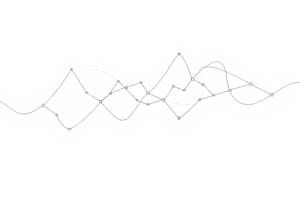Podcast
Questions and Answers
What is a signal?
What is a signal?
A mathematical indicator that conveys information or a gesture, action, or sound used to convey information.
Which of the following describes analog signals?
Which of the following describes analog signals?
- Only uses two values: 0 and 1
- Discontinuous signals
- Uses sine waves (correct)
- Highly accurate
Which statements are true about digital signals? (Select all that apply)
Which statements are true about digital signals? (Select all that apply)
- Continuous signals
- Subject to noise
- Uses only two values: 0 and 1 (correct)
- Less accurate than analog signals
The formula of Ohm's law is V = _____
The formula of Ohm's law is V = _____
What does a voltmeter measure?
What does a voltmeter measure?
What is the relationship between frequency and period?
What is the relationship between frequency and period?
What is the amplitude in relation to a sine wave?
What is the amplitude in relation to a sine wave?
What is the difference between AC and DC?
What is the difference between AC and DC?
Match the following signal types with their characteristics:
Match the following signal types with their characteristics:
Flashcards are hidden until you start studying
Study Notes
What is a Signal?
- A mathematical indicator that conveys information between two observers.
- Can take the form of gestures, actions, sounds, electrical impulses, or radio waves.
- Represents any physical quantity causing a reaction or change.
Types of Signals
Analog Signals
- Continuous signals defined with respect to time, often using sine waves.
- Examples include sound, human voice, and traditional telephones.
Digital Signals
- Utilizes only two values (0 and 1), representing data in discrete values.
- Discontinuous and typically less accurate than analog; samples from analog signals.
- Not subject to noise and represented by square waves.
Logic Voltage Levels
- Voltage represents the electric energy charge difference (measured in volts).
- Current indicates the flow rate of electric charge (measured in amperes).
Ohm’s Law
- Equation: V = IR, where V is voltage, I is current, and R is resistance.
- Example calculation: Given 10 volts and 2 amperes, resistance (R) calculates to 5 ohms.
Definitions
- Voltmeter: Measures voltage or potential difference between two points in a circuit.
- Ammeter: Measures electric current in amperes.
- AC (Alternating Current): Electric charge flow reverses direction.
- DC (Direct Current): Unidirectional flow of electric charge, commonly from batteries.
Digital vs. Analog Signals Comparison
- Analysis: Analog signals are difficult to analyze; digital signals are easier.
- Representation: Analog is continuous; digital is discontinuous.
- Storage: Analog has infinite memory; digital is easily stored.
- Noise/Distortion: Analog is subject to noise; digital is not.
- Common Examples: Analog includes human voice and thermometers; digital includes computers and smartphones.
Characteristics of Analog Signals
- Amplitude: Intensity value at time t.
- Frequency: Number of cycles completed per second, expressed in Hertz (Hz).
- Phase: Position of the waveform with respect to time, measured in degrees or radians.
Frequency and Period
- Frequency: Cycles or vibrations per unit time; 1 Hz = 1 cycle/second.
- Period: Time taken to complete a cycle, with formulas T = 1/f and f = 1/T.
Additional Notes on Wave Characteristics
- In Phase: Signals of the same frequency aligned at the same time.
- Out of Phase: Signals of the same frequency not aligned in time.
Studying That Suits You
Use AI to generate personalized quizzes and flashcards to suit your learning preferences.




